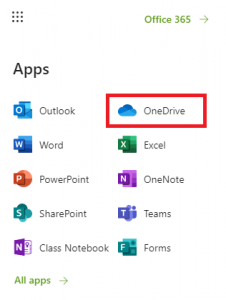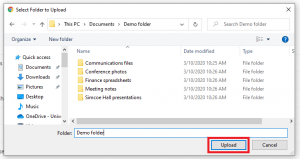When you work remotely, you have two primary options to securely access your work environment: OneDrive and Cisco Secure Client VPN. This web page will help you determine which service to use when, and the steps you need to take to ensure you have access.
Please select the service(s) you need access to and read the accompanying recommendations. We ask that you test the option you select prior to working remotely to ensure that you have access to these services when you need them.
Identify your options
-
I need to access Microsoft Office, email and my computer files remotely. I do not need to access ROSI and AMS/SAP.
When working remotely on a U of T laptop or your home computer, most regular users will find that using Office 365 tools such as Outlook, OneDrive and SharePoint will be sufficient. As long as you are logged in, you can use Office 365 on the web on any device. Here are some key applications you can use when working remotely:
Outlook: When working remotely, you can access your University email by using the UTmail+/Outlook web client. If you have not used Outlook Online before, you can learn how to access it through the U of T Digital Workplace UTmail+ page.
OneDrive: OneDrive will be a key application for you to use when you work remotely: it allows you to access your computer files from any device, anywhere in the world. If you haven’t used OneDrive before, the set up is fast and easy. All you need to do is:
- Open the online OneDrive app by logging in to your online Outlook/UTmail+ account and clicking on the waffle in the top left corner. Select the OneDrive tool.

- When you open OneDrive you will see a list of all of your files that are currently uploaded.
- To add new files from your computer, simply click Upload and select whether you would like to upload Files or a Folder.

- Select the items that you would like to add and click Upload. The files will now be housed in your OneDrive!

As you can see from the image, you can upload all the folder and file types you need to work remotely. And you will never have to worry about running out of space – OneDrive has a storage limit of 1 TB.
If you have the OneDrive application downloaded to your computer, you can also use the sync option to ensure that any files edited on OneDrive are also edited on your computer. To learn more about this option, access this Microsoft article.
Microsoft Office applications such as Word, Excel and PowerPoint: Online versions of Word, Excel and PowerPoint are all available to you. To learn more about how to access them with your U of T account, you can explore the application pages from the University’s Microsoft 365 website.
- Open the online OneDrive app by logging in to your online Outlook/UTmail+ account and clicking on the waffle in the top left corner. Select the OneDrive tool.
-
I need to access ROSI remotely.
If you need to access ROSI from your U of T laptop or home computer you should use the Cisco Secure Client VPN. With the VPN, you can access ROSI from your home or work computer when off-site. You will need to be enrolled in UTORMFA. To set up the VPN, follow the instructions on the AdminsysVPN (Cisco Secure Client VPN) page.
Please remember that confidential information should never be stored locally as per our Manage Confidential Information in Browsers page. If you have any questions about accessing ROSI from home, please log a ticket through the Enterprise Service Centre.
-
I need to access administrative systems such as AMS/SAP remotely.
You will need to be enrolled in UTORMFA and the instructions for SAP GUI installation can be found here: https://easi.its.utoronto.ca/help/software-hardware/.
Once you install SAP GUI, you will have to set up Cisco Secure Client VPN. View instructions.
Frequently asked questions
OneDrive
OneDrive
Yes, OneDrive is secure. To learn more about how OneDrive safeguards your data in the cloud, please read this article from Microsoft.
Good news – all University of Toronto staff, students and faculty have access to OneDrive! Getting started is easy: to learn more about how you can use OneDrive at U of T, visit EASI’s OneDrive page.
Access OneDrive training through the University’s SuccessFactors website.
You do not need to use a VPN to access your files on OneDrive. You can use the Microsoft web interface to securely access your OneDrive files from anywhere in the world.
The simplest option for accessing your work files from home is to upload them to OneDrive. OneDrive is available to all staff, students and faculty at the University of Toronto, and you can access it through the Office 365 web interface.
To learn how to upload your computer files to OneDrive before you work from home, access OneDrive training through the University’s SuccessFactors website.
Using Microsoft 365 remotely
Using Microsoft 365 remotely
If you get this message, simply click Cancel and relaunch the Teams app.
Yes, people can now dial in to University of Toronto Teams meetings via phone. For more information on how this works, please reference the FAQ page.
University of Toronto community members have access to online versions of Microsoft Office applications like Word, Excel and PowerPoint. To learn more about how to access these tools through the web, visit uoft.me/dwO365.
When working from home, you can access your University email from any device by using the UTmail+/Outlook web client. If you have not used Outlook Online before, you can learn how to access it through the U of T Digital Workplace UTmail+ page.
Yes. You can access SharePoint from any web browser on any device.
Additional questions
Non DW FAQ
You can absolutely work from home if you set up the eToken service.
You should use a VPN when:
- You do not have access to a home computer, but could bring your work laptop home. In this instance, you would use Cisco Secure Client VPN to access secure systems such as ROSI and AMS/SAP.
- You have your U of T computer at home, but you need access to your I: or H: drives. In this instance, you would use UTORcsi.
- You need access to specific departmental shares.
The work from home option you select will be determined by whether you have a U of T laptop that you can bring home.
